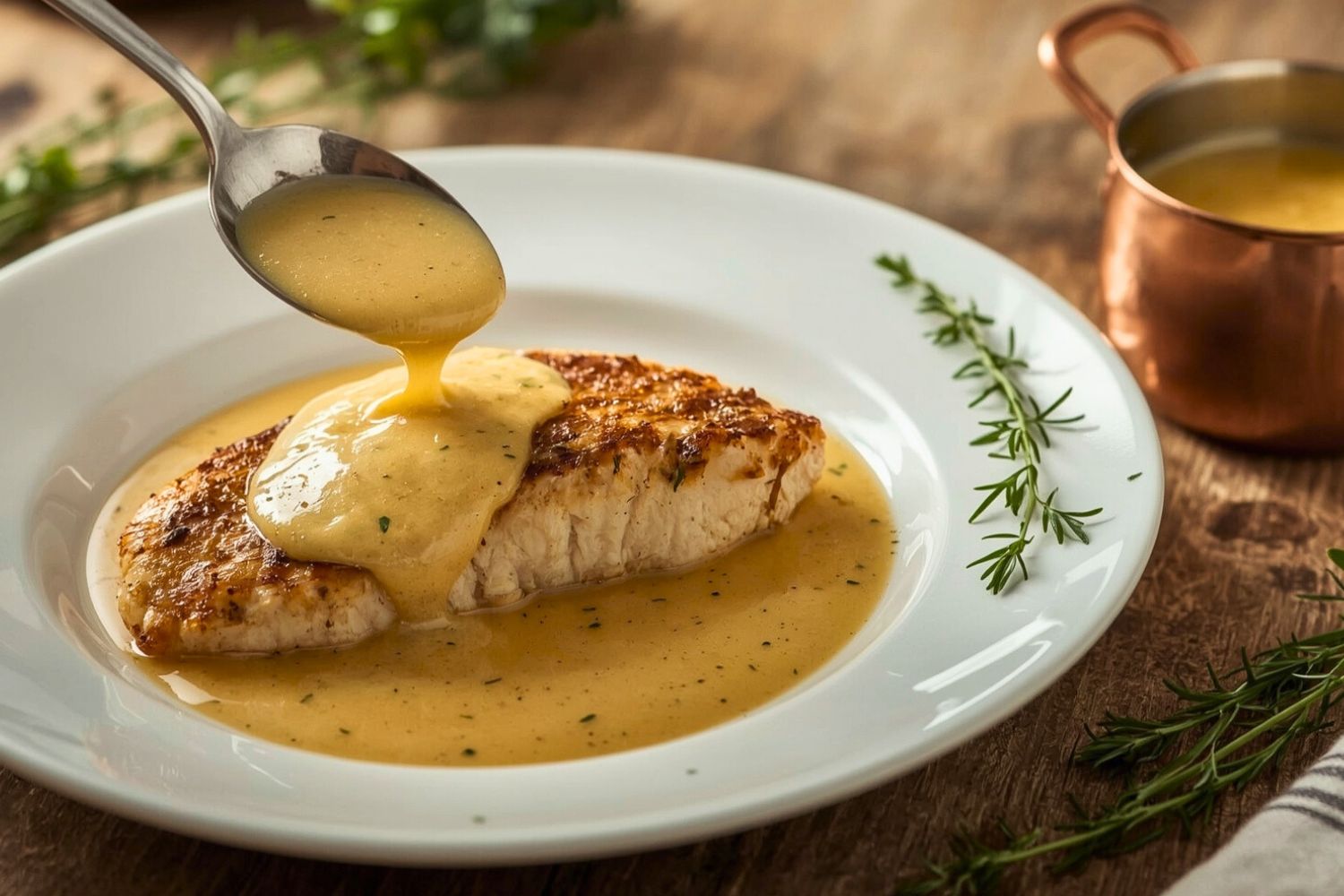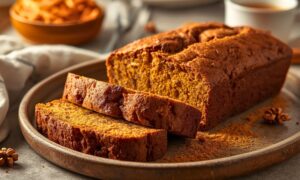Ever wondered how French chefs get that silky, restaurant style finish on their sauces? The secret is simpler than you’d think, Mustard Velouté Sauce. I first tasted it in a cozy Paris bistro, creamy, tangy, and just elegant enough to turn a basic dish into something unforgettable. The best part? It took less than 20 minutes to make. That experience changed how I approach sauces at home.
In this post, you’ll learn how to create the Best Mustard Velouté Sauce. We’ll go over the ingredients, the step by step process, and a few chef tips to make it foolproof. Whether you’re drizzling it over chicken, fish, or roasted vegetables, this sauce adds instant elegance to your plate.
The Best Mustard Velouté Sauce is rich yet light, tangy yet smooth. It blends classic French technique with simple ingredients you probably already have. No fancy tools, no stress, just butter, broth, and a good whisk.
Let’s make the Best Mustard Velouté Sauce your new go to for effortless, restaurant worthy meals. Ready to stir up something delicious?
Ingredients & Smart Swaps

You’ll need these ingredients in cooking order:
- 2 tablespoons butter (unsalted works best)
- 2 tablespoons all purpose flour
- 1½ cups warm chicken or vegetable stock
- 3 tablespoons Dijon mustard (don’t skimp here)
- ¼ cup heavy cream
- 1 tablespoon whole grain mustard (optional, but worth it)
- Salt and white pepper to taste
- Fresh thyme or tarragon (just a pinch)
Now, let’s talk substitutions because life happens. Can’t do dairy? Swap butter for olive oil and use coconut cream instead. It’ll taste different but still delicious. Living somewhere that doesn’t stock Dijon? Regular yellow mustard works, but use less, it’s sharper than you think.
Most cookbooks hide this secret: your stock quality makes or breaks this sauce. Those little bouillon cubes? They’ll work in a pinch, but homemade or good store bought stock creates the real magic. You want something with body, not just salt water.
Flour choice matters too. All purpose works best, but cake flour works too. Got some? It creates silkier texture. Gluten free folks, cornstarch works beautifully just use half the amount and mix it with cold stock first.
Fresh herbs aren’t just garnish here. Thyme brings earthy warmth, while tarragon adds that subtle anise note that makes people wonder what your secret is. Can’t find fresh? Dried works, but use about a third of what you’d use fresh.
The Science Behind the Sizzle
You just created France’s mother sauce, velouté. The name means “velvety” taste it and you’ll understand why.
Flour proteins bind with fat, creating thickening magic that holds everything together. This isn’t just thickening you create a stable emulsion that won’t break when you reheat it tomorrow.
That gentle cooking of flour and butter? You eliminate raw flour taste while creating a base that’ll hold onto liquid without getting gluey. It’s food science at its most practical.
Mustard adds more than flavor those tiny seeds contain natural emulsifiers that help keep your sauce smooth. That’s why mayo works, and it’s why mustard makes sauces more stable. Your grandmother might not have known the chemistry, but she understood the results.
Temperature control drives everything here. Too hot, and the proteins in your cream will curdle. Too cool, and nothing comes together properly. That gentle simmer hits the sweet spot where flavors meld without breaking.
Step by Step Magic

Melt butter in heavy saucepan over medium heat. Don’t rush, let it melt and foam, but don’t brown it. That gentle sizzle is your friend.
Sprinkle in your flour and whisk like your life depends on it. This roux forms your sauce foundation. Cook it for about two minutes, stirring constantly. You’re not looking for color here, just getting that raw flour taste to disappear.
Here’s where things get interesting. Slowly and I mean slowly, start adding your warm stock. We’re talking a thin stream while you whisk. This moment separates pros from beginners. Rush it, and you’ll have lumps that’ll haunt your sauce forever.
The mixture thickens almost instantly, just keep whisking. Keep whisking and adding stock until it’s all incorporated. The sauce should coat the back of your spoon but still flow freely. Think heavy cream consistency, not pudding.
Now comes the fun part. Whisk in that Dijon mustard, and watch the sauce transform into something golden and gorgeous. Taste it, you should get that gentle tang without it being aggressive. Want more depth? Add the whole grain mustard now.
Pour in your cream and let everything simmer gently for about five minutes. Don’t let it boil hard or it might break on you. Just a gentle bubble around the edges. Season with salt and white pepper white pepper keeps the color pristine, but black works if that’s what you’ve got.
Final touch: those fresh herbs. Chop them fine and stir them in at the very end. The residual heat will release their oils without cooking them to death.
Making It Beautiful & Delicious

A proper velouté should pour like silk and coat without overwhelming. When you drag your finger across the back of a spoon dipped in the sauce, it should leave a clean line that doesn’t immediately fill in.
For plating, less is more. This isn’t gravy, it’s an elegant coating that enhances without hiding. Drizzle it around the plate, not over everything. Let your protein shine while the sauce adds that professional touch.
This sauce is a chameleon that pairs beautifully with so many things. Roasted chicken becomes bistro worthy. Pan seared fish gets elevated to fine dining. Even simple steamed vegetables become something special.
Wine pairing? Think crisp whites Sauvignon Blanc, Pinot Grigio, or a buttery Chardonnay if you’re feeling fancy. The acidity cuts through the richness while complementing the mustard’s tang.
Side dishes that work beautifully: roasted asparagus, braised leeks, or simple buttered potatoes. The sauce bridges flavors and ties everything together into one cohesive, delicious meal.
Wrapping It Up
Mustard velouté transforms ordinary meals into memorable experiences. This technique opens doors to endless variations and builds your confidence to improvise.
Remember, cooking rewards understanding, not just following recipes. Master this roux based sauce, and you can adapt it endlessly. Different mustards, herbs, even a splash of wine the foundation stays the same, but the possibilities multiply.
Keep this recipe in your back pocket for impressive without stress moments. It comes together in about fifteen minutes, uses ingredients you probably have on hand, and delivers results that’ll have people asking for your secret.
The most important tip? Taste as you go. Your palate guides you best, and every batch might need tiny adjustments. Trust yourself, embrace the process, and enjoy creating something beautiful in your kitchen.
Frequently Asked Questions
Why is my velouté sauce lumpy?
This usually happens when the stock gets added too quickly or isn’t warm enough to incorporate smoothly. Next time, heat your stock until it’s steaming and then add it gradually in small amounts while whisking constantly to ensure a silky texture. If you’ve already got lumps, don’t worry, just strain the sauce through a fine mesh sieve or cheesecloth. It might take a minute, but it’ll absolutely save the day and leave you with a smooth, velvety finish.
Can I make mustard velouté ahead of time?
Absolutely! This sauce actually improves after sitting for a bit, allowing the flavors to meld beautifully. Cover it tightly and store it in the fridge for up to three days without worry. When reheating, do it gently over low heat, whisking occasionally to bring back its smooth texture. You might need to add a splash of stock or even a bit of cream if it’s too thick, helping restore that silky, pourable consistency. It’s still just as delicious, if not better, the next day!.
My sauce broke, can I fix it?
Don’t panic! Usually this happens from overheating, which can cause the fats and liquids to separate. Remove the sauce from the heat immediately and whisk in a tablespoon of cold cream, milk, or stock to help bring it back together. If that doesn’t work, strain out any solids using a fine mesh sieve, discard the curdled bits, and start the roux again with fresh butter and flour. Once it’s smooth and warm, gradually whisk your broken sauce back in a little at a time, stirring constantly to help it reemulsify and regain its silky texture.
What’s the difference between velouté and béchamel?
Great question! Béchamel uses milk as the liquid base, while velouté uses stock, typically chicken or veal. Both start with a white roux, but velouté has a deeper, more complex flavor because of the stock. Think of velouté as béchamel’s more sophisticated, savory cousin, perfect for sauces that need an extra layer of richness.
Can I freeze leftover mustard velouté?
It’s not ideal, cream based sauces often tend to separate when frozen and thawed, ruining their texture. If you must freeze it, do so before adding the cream, then stir in fresh cream when you reheat for better consistency and flavor. But honestly, it’s so quick and easy to make fresh from scratch that it’s usually worth starting over every time.

Swiftly Captions by Tina Smith — Quick, flavorful food recipes made simple, bringing fresh inspiration to your kitchen every day






